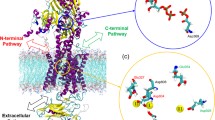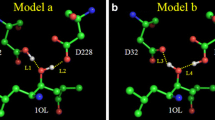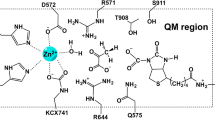Abstract
Three different pKa prediction methods were used to calculate the pKa of Lys115 in acetoacetate decarboxylase (AADase): the empirical method PROPKA, the multiconformation continuum electrostatics (MCCE) method, and the molecular dynamics/thermodynamic integration (MD/TI) method with implicit solvent. As expected, accurate pKa prediction of Lys115 depends on the protonation patterns of other ionizable groups, especially the nearby Glu76. However, since the prediction methods do not explicitly sample the protonation patterns of nearby residues, this must be done manually. When Glu76 is deprotonated, all three methods give an incorrect pKa value for Lys115. If protonated, Glu76 is used in an MD/TI calculation, the pKa of Lys115 is predicted to be 5.3, which agrees well with the experimental value of 5.9. This result agrees with previous site-directed mutagenesis studies, where the mutation of Glu76 (negative charge when deprotonated) to Gln (neutral) causes no change in Km, suggesting that Glu76 has no effect on the pKa shift of Lys115. Thus, we postulate that the pKa of Glu76 is also shifted so that Glu76 is protonated (neutral) in AADase.

Simulated abundances of protonated species as pH is varied





Similar content being viewed by others
References
Li H, Robertson AD, Jensen JH (2005) Very fast empirical prediction and rationalization of protein pKa values. Proteins Struct Funct Bioinforma 61(4):704–721
Bas DC, Rogers DM, Jensen JH (2008) Very fast prediction and rationalization of pKa values for protein–ligand complexes. Proteins Struct Funct Bioinforma 73(3):765–783
He Y, Xu J, Pan X-M (2007) A statistical approach to the prediction of pKa values in proteins. Proteins Struct Funct Bioinforma 69(1):75–82
Bashford D, Karplus M (1990) pKa’s of ionizable groups in proteins: atomic detail from a continuum electrostatic model. Biochemistry 29(44):10219–10225
Yang A-S, Honig B (1993) On the pH dependence of protein stability. J Mol Biol 231(2):459–474
Yang A-S, Gunner MR, Sampogna R, Sharp K, Honig B (1993) On the calculation of pKas in proteins. Proteins Struct Funct Genet 15(3):252–265
Jensen JH, Li H, Robertson AD, Molina PA (2005) Prediction and rationalization of protein pK a values using QM and QM/MM methods. J Phys Chem A 109(30):6634–6643
Alexov EG, Gunner MR (1997) Incorporating protein conformational flexibility into the calculation of pH-dependent protein properties. Biophys J 72(5):2075–2093
Georgescu RE, Alexov EG, Gunner MR (2002) Combining conformational flexibility and continuum electrostatics for calculating pKas in proteins. Biophys J 83(4):1731–1748
Song Y, Mao J, Gunner MR (2009) MCCE2: improving protein pK a calculations with extensive side chain rotamer sampling. J Comput Chem 30(14):2231–2247
Bashford D, Gerwert K (1992) Electrostatic calculations of the pKa values of ionizable groups in bacteriorhodopsin. J Mol Biol 224(2):473–486
Bashford D (2004) Macroscopic electrostatic models for protonation states in proteins. Front Biosci 9:1082–1099
Simonson T, Carlsson J, Case DA (2004) Proton binding to proteins: pK a calculations with explicit and implicit solvent models. J Am Chem Soc 126(13):4167–4180
Jones DT, Woods DR (1986) Acetone-butanol fermentation revisited. Microbiol Rev 50(4):484–524
Hamilton GA, Westheimer FH (1959) On the mechanism of the enzymatic decarboxylation of acetoacetate I. J Am Chem Soc 81(23):6332–6333
Fridovich I, Westheimer FH (1962) On the mechanism of the enzymatic decarboxylation of acetoacetate. II J Am Chem Soc 84(16):3208–3209
Laursen RA, Westheimer FH (1966) The active site of acetoacetate decarboxylase I. J Am Chem Soc 88(14):3426–3430
Westheimer FH (1995) Coincidences, decarboxylation, and electrostatic effects. Tetrahedron 51(1):3–20
Frey PA, Kokesh FC, Westheimer FH (1971) Reporter group at the active site of acetoacetate decarboxylase. I. Ionization constant of the nitrophenol. J Am Chem Soc 93(26):7266–7269
Kokesh FC, Westheimer FH (1971) Reporter group at the active site of acetoacetate decarboxylase. II. Ionization constant of the amino group. J Am Chem Soc 93(26):7270–7274
Westheimer FH, Schmidt DE (1971) pK of the lysine amino group at the active site of acetoacetate decarboxylase. Biochemistry 10(7):1249–1253
Ho M-C, Ménétret J-F, Tsuruta H, Allen KN (2009) The origin of the electrostatic perturbation in acetoacetate decarboxylase. Nature 459(7245):393–397
Schrodinger LLC (2015) The PyMOL Molecular Graphics System, version 1.3 r1. Schrödinger, LLC, New York
Nicholls A, Honig B (1991) A rapid finite difference algorithm, utilizing successive over-relaxation to solve the Poisson-Boltzmann equation. J Comput Chem 12(4):435–445
Rocchia W, Alexov E, Honig B (2001) Extending the applicability of the nonlinear Poisson−Boltzmann equation: multiple dielectric constants and multivalent ions. J Phys Chem B 105(28):6507–6514
Case DA, Darden TA, Cheatham TE, Simmerling CL, Wang J, Duke RE, Luo R, Crowley M, Walker RC, Zhang W et al. (2008) Amber 10. University of California, San Fransisco
Onufriev A, Bashford D, Case DA (2004) Exploring protein native states and large-scale conformational changes with a modified generalized Born model. Proteins Struct Funct Bioinforma 55(2):383–394
Duan Y, Wu C, Chowdhury S, Lee MC, Xiong G, Zhang W, Yang R, Cieplak P, Luo R, Lee T et al (2003) A point-charge force field for molecular mechanics simulations of proteins based on condensed-phase quantum mechanical calculations. J Comput Chem 24(16):1999–2012
Snyder MA, Chatterjee A, Vlachos DG (2005) Net-event kinetic Monte Carlo for overcoming stiffness in spatially homogeneous and distributed systems. Comput Chem Eng 29(4):701–712
Tighezza A, Aldhayan D, Almthar A (2011) Implementation of net-event Monte Carlo algorithm in chemical kinetics simulation software of complex isothermal reacting systems. J Saudi Chem Soc 15(4):351–355
Ishikita H (2010) Origin of the pK a shift of the catalytic lysine in acetoacetate decarboxylase. FEBS Lett 584(15):3464–3468
Acknowledgments
The authors thank NSERC for funding and Sharcnet and Compute Canada for computational resources.
Author information
Authors and Affiliations
Corresponding author
Additional information
This paper belongs to Topical Collection Festschrift in Honor of Henry Chermette
Electronic supplementary material
Below is the link to the electronic supplementary material.
ESM 1
(PDF 247 kb)
Rights and permissions
About this article
Cite this article
Liu, Y., Patel, A.H.G., Burger, S.K. et al. Benchmarking pKa prediction methods for Lys115 in acetoacetate decarboxylase. J Mol Model 23, 155 (2017). https://doi.org/10.1007/s00894-017-3324-x
Received:
Accepted:
Published:
DOI: https://doi.org/10.1007/s00894-017-3324-x




